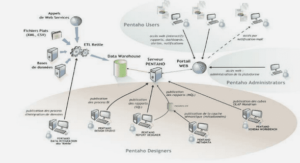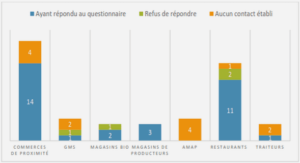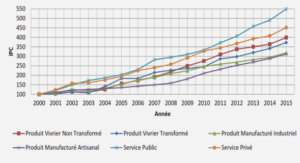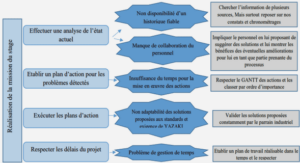Link between questionnaires and performance on the attention task
We computed a validity score by calculating the difference between RT in the invalid and the valid conditions (RT invalid – RT valid). Higher validity scores indicate that participants were faster in the valid condition than in the invalid condition, suggesting attentional capture by the cue. The reverse would reflect attentional avoidance of the cue. Validity scores were calculated for each type of cue. We then examined wh ether validity scores were correlated with questionnaire scores (see Table 3).
We did not observe any correlation between validity scores on the cueing task and questionnaires scores. It seems that performance on the attention task was not modulated by trait anxiety, depression or post-traumatic stress symptoms in this sample of students.
Discussion
This first experiment showed no significant validity effect when the cue was threatening and a reversed validity effect wh en the cue was neutral. This reversed validity effect could be an IOR but the presentation delay between the cue and the target seems to be a little shorter to appear (Klein, 2000). There was no effect of the processing strategies on the validity effect, and this factor also did not interact with cue type or the emotional state of participants. These results reinforce the inconsistency observed from previous studies, as different studies have found faster or slower attentional disengagement from threatening stimuli, compared to neutral stimuli (Koster, Crombez, Verschuere, & De Houwer, 2004; Koster et al., 2007; Stormark & Hugdahl, 1996; Stormark et al., 1995). It is possible that the visu al properties related to the horizontal presentation of stimuli may influence the results, in line with possible reading effect. It also possible that the different abilities ofthe hemisphere to process relevant information in their contralateral hemifield (Smigasiewicz et al., 2014) add sorne variability that we didn’t consider in this experiment. However additional analysis in this experiment did not confmn either ofthese two hypotheses. Maybe, in the Experiment 1 the manipulations pro duce the IOR effect with neutral stimuli and disappear this effect when the participants pay attention to the emotional cue because are relevant for the task. There are other studies where the emotional valence of the target is manipulated and the JOR is override for threatening stimuli (e.g.: Pérez-Dueftas et al., 2014). What happens when cues and target are presented on the vertical meridian line.
Experiment 2
Method
Participants. Participants were 35 students from the Université du Québec à TroisRivières (27 women; Mage = 21.9, SD = 1.7). Exclusion criterion was not to have normal or corrected to normal vision.
Procedure. We used the same procedure as in Experiment 1, except that the cues and targets appeared above or below the fixation point (see Figure 5). Distance between the central fixation point and center of the cue word was 1.6 0 visual angle. This distance allows to have equivalent distance between stimuli and central fixation point in
Experiment 1. The center of the target was also located 1.6 0 of visual angle from the central fixation point. Participants’ tasks were the same as in Experiment 1 except that the attention task was presented in three blocks. The first consisted of a practice block with 72 trials intended to familiarize participants with the task. It included only neutral eues (chosen randomly in the database: http://www.lexique.org/) that were not used in the experimental blocks. In this block, the processing strategy induced was semantic only (question related to the previously presented eue was: Is it an object?).
The two experimental blocks followed. Each experimental block consisted of72 trials with 12 neutral words and 12 threatening words. Each was presented three times (see section eues evaluation for details about words used as eues in Experiment 2).
Stimuli. We used different words than in Experiment 1. The two experimental blocks also presented different words. We ensured that neutral and threatening words within a block differed on emotional value (p < .05) and did not differ on the number of letters (p > .05). We also ensured that neutral words across blocks were not different in terms of emotional valence and number of letters (p > .05). We finally ensured that threatening words across blocks did not differ in terms of emotional valence and number of letters (p > .05).
Cue evaluatioD. We used exactly the same cue evaluation procedure as in Experiment 1 to verify that the 35 students who took part in the attention task judged the two categories ofwords (neutral vs. threatening) to be different on emotional valence (see appendix B). Participants indeed evaluated the neutral and threatening words as different in terms of emotional value (Meval neutral = 1.23, SD = 0.17; M eval threatening = 4.79, SD = 0.59; t (26.952) = 28.54,p < .001). The average number ofletters in neutral words (M= 5.92, SD = 1.41) and threatening words (M= 6.62, SD = 1.93) did not significantly differ, (t (46) = 1.45, P > .15).
Questionnaires. We used exactly the same questionnaires as in Experiment 1.
Data analysis. The analyses included 33 participants (25 women; M age = 21.9, SD = 1.8). Two participants were excluded from analyses because they failed to reach a minimum accuracy of 75% in target discrimination. The main behavioral dependent measure was participants’ RTs to determine target type. We again considered average mean per condition, including only correct answers (92%). Then we executed the same data analysis as in Experiment 1.
Results
Questionnaires
Table 4 presents descriptive statistics of self-report questionnaires and Table 5 presents correlations between self-report questionnaires for 33 students.
Behavioural results. An analysis ofvariance conducted on RTs revealed a significant three way interaction between validity (valid vs. invalid), cue type (threatening vs. neutral) and processing strategy (semantic vs. emotional) F(l, 32) = 4.19, p = .049, 1l2p = 0.12\ (see Figure 6); a marginal significant two-way interaction between cue type and 1 It is necessary to take into consideration the fact that the experimental design of the study has an effect on effect size calculation (Olejnik & Algina, 2003). Accordingly, here, effects sizes like partial eta squared given by SPSS can be compared only with the same kind of design.
processing strategy F(1 ,32) = 3.54, p = .069, 112p = 0.1 and a significant two-way interaction between validity condition and cue type F(I ,32) = 4.24, p = .043, 112p = 0.12.
There were no other significant effects. We conducted a second stage of analysis examining the data separately for the blocks inducing emotional and semantic processing strategies.
When participants answered the emotional question, there was a significant interaction between cue type and validity F(1 , 32) = 5.54, p = .025, 112p = 0.15. Post-hoc analyses showed that when cues were neutral, RTs were faster in the valid compared to the invalid condition t(32) = 2.27, p = .03, 112 = 0.14. When the cues were threatening, there was no statistically significant difference between the valid and the invalid condition (p = .17).
When participants answered the semantic question, there was no interaction between cue type and validity (p > .05, 112p = .07), and a marginally significant main effect of validity t(32) = 3.68,p = .06, 112 = 0.30 where RTs were fasterin valid compared to invalid condition.
Cross-study comparison on attention al task
An analysis ofvariance conducted on RTs revealed a non significant four-way interaction between experiment (Experiment 1 vs. Experiment 2), validity condition (valid vs. invalid), target type (threatening vs. neutral) and processing strategy (semantic vs. emotional) F(1,73) = 2.15, p > .05,
1l2p = 0.03. There was significant three-way interaction between validity condition, cue type and experiment F(1 ,73) = 10.42, P < .05, 1l2p = 0.12. We also have two-way interaction between cue type and experiment F(1 ,73) = 6.32, P < .05, 1l2p = 0,08, and between validity condition and experiment F(1 ,73) = 3,32, P = .07, 1l2p = 0,04. Post-hoc analyses showed for this last two-way interaction that reaction time did not differ significantly between invalid (M = 1111 ,77) and valid condition (M = 1127,12) in Experiment 1 t( 41) = -0,97, p = .34, neither in Experiment 2, (Minvalid = 1018,80) (Mvalid = 997,94) t(32) = 1,57,p = .13. Additional analyses showed that reaction times in invalid condition in Experiment 1 were not significantly superior (M = 1111 ,77) from Experiment 2 (M = 1018,80) t(73) = 1,32, P = .19, and reaction times in valid condition in Experiment 1 were marginally superior (M = 1127,12) from Experiment 2 (M = 997,94) t ‘(71 ,97) = 1,92,p = .06.
Discussion
The purpose of this research was to examine the impact of processing strategies on attentional orientation toward emotional and neutral stimuli with a horizontal presentation (Experiment 1) and then with a vertical presentation (Experiment 2). The findings show that overall, there was a validity effect in Experiment 2, where stimuli were presented vertically, while there was no validity effect in Experiment 1, where stimuli were presented horizontally. This experiment also showed no effect of processing strategies.
From these results, we conclude the validity effect in a cueing paradigm can be more effectively detected with a vertical presentation of stimuli.
|
Table des matières
Introduction
Contexte théorique
L’attention
Attention et émotion
Attention et stratégie de traitement de l’information
Attention et environnement complexe
Attention chez les premiers répondants
Synthèse et objectifs
Article 1. Étude préliminaire. Attentional processing of neutral and threatening words in the cueing paradigm: horizontal or vertical presentation?
Abstract
Introduction
Experiment 1
Method
Participants
Procedure
Stimuli
Cue evaluation
Questionnaires
Data analysis
Results
Questionnaires
Behavioural results
Lillk between questionnaires and perfonnance on the attention task
Discussion
Experiment 2
Method
Participants
Procedure
Stimuli
Cue evaluation
QuestIonnaIres
Data analysis
Results
QuestIonnaIres
Behavioural results
Link between questionnaires and perfonnance on the attention task
Cross-study comparison on attentional task
Discussion
Appendix A. Words list from experiment 1
Appendix B. Words list from experiment 2
Appendix C. Words changed from experiment 1 to experiment 2
References
Article 2. Can threat detection be enhanced using processing strategies by police trainees and officers?
Abstract
Introduction
Experiment 1
Method
Participants
Apparatus
Material
Pilot study: Stimuli selection and validation
Questionnaires
Procedure
Data analysis
Results
Questionnaires
Behavioural results
Link between questionnaires and performance on the attention task
Results of cue evaluations
Discussion
Experiment 2
Method
Participants
Material
Stimuli, questionnaires and procedure
Data analysis
Results
Questionnaires
Behavioural results
Link between questionnaires and performance on the attention task
Discussion
General Discussion
Appendix A. Words list
References
Article 3. The influence of an emotional processing strategy on visual threat detection by police trainees and officers
Abstract
Introduction
Experiment 1
Method
Design
Participants
Stimuli
Questionnaires
Procedure
Data analysis
Results
Questionnaires
Behavioral results
Link between questionnaires and performance on the visual search task
Experiment 2
Method
Design
Participants
Stimuli, Questionnaires & Procedure
Data analysis
Results
QuestIonnaIres
Behavioral results
Link between questionnaires and performance on the visual search task
Link between years of services and performance on the visual search task
Cross-study comparison on attentional task
Cross-study comparison on questionnaires
Discussion
References
Conclusion générale
Références générale
![]() Télécharger le rapport complet
Télécharger le rapport complet




